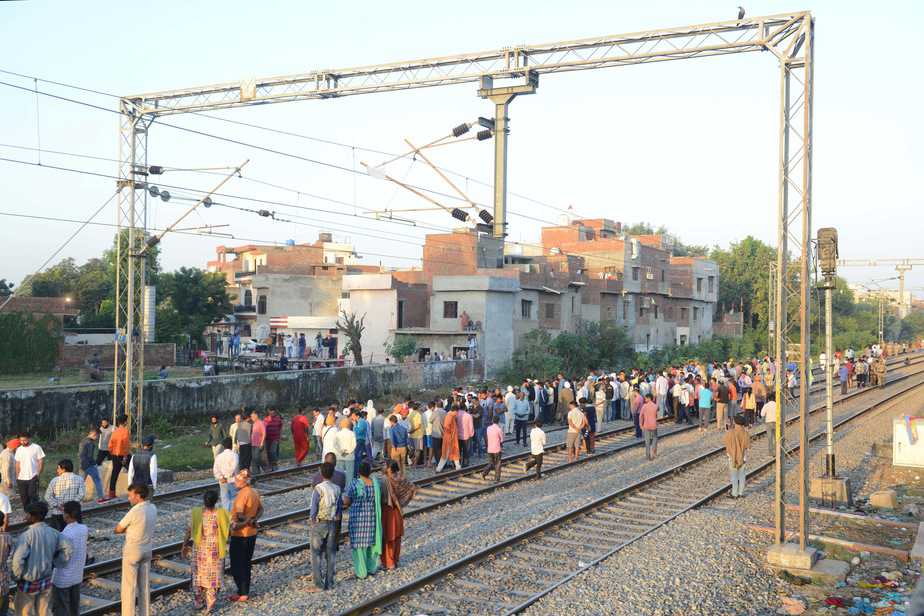The Amritsar train tragedy can be seen as the manifestation of the insignificance of human life in India’s public spaces. The free run of absurd tragedies has led to a kind of fatalist resignation
What lies in an evening? A few seconds of absurdity, dismembered body parts and scattered slippers on a railway track. In a country where life is cheap, absurdity doesn’t only strike in the face at street corners. With deadly regularity, it traps clueless lives under a collapsing flyover, tramples over them in a stampede, pulls them into an uncovered manhole and crushes them under wheels of a speeding vehicle.
Last evening it mowed down at least 61 unsuspecting Dussehra revellers on a railway track at Joda Fatak level crossing near Amritsar. The death toll may go up. At least 62 are reported injured.
The free run of absurd tragedies has somehow led to a kind of social stoicism in which a sense of fatalist resignation soon takes over the numbness of horror. According to reports, the victims had gathered on the railway track to get a better view of the burning of the Ravana effigy organised at the Dhobi Ghat ground. According to a report in Indian Express, they were “taking videos of the burning Ravan as the first of the trains, 74643 Jalandhar-Amritsar DMU, ran them over. The second train, the 13006 Amritsar-Howrah Express, sped past seconds later and some of those who had jumped on the second set of tracks to escape the first were caught under it.”
The nature of tragedy is difficult to classify. It blurs the lines between a train tragedy and event/crowd management disaster—the blame game has already begun, revolving around Indian Railways, the civil administration (and, by extension, the state government) and the organisers (which mainly consisted of members of the Congress party).
The allegations that no official permission was taken for the event from the municipal corporation (only the office of the Deputy Commissioner of Police had been informed about the event), the alleged hurried departure of chief guest Navjot Kaur Sidhu (wife of former cricketer and minister in Punjab government, Navjot Singh Sidhu) and questions about the response mechanism of Railways are already setting the tone for the predictable politicisation of the disaster.
Indian Railways has distanced itself from any responsibility for the accident. “It would be wrong to say that Railways is responsible for this accident. There are two manned level-crossing on that track, both were close. It is a main line. There is no speed restriction there,” said Ashwani Lohani, Chairman of the Railway Board.
In his statement, the Railway Board chairman also said the tragedy occurred 400 metres away from the manned crossing, the speed was slowed down to 60-65 kmph (from 90 kmph) and emergency brakes aren’t to be applied at that speed since that would lead to a bigger tragedy. He said Indian Railways had not been informed about the event and even the district administration had no information.
As in the case with most of such tragedies in the country, relevant as well as irrelevant allegations are spread about the role of VIP culture, long speeches being made without any concern for the safety of the crowd gathered and the delay in the completion of the event.
As the area is mostly home to migrant workers from Uttar Pradesh and Bihar, they constitute a sizeable number of victims although the identities of all the dead have still not been established.
In plain sight, it seems to be a lethal lapse of judgment in choosing such a spot for viewing the festive spectacle. But that doesn’t absolve the sheer callousness that defines the public safety paradigm—or the lack of it—in the country. As a reminder of how quickly such tragedies disappear from public memory, only four years ago, 32 lives were lost on another Dusshera day in Patna. On October 3, 2014, when revellers were exiting Patna’s Gandhi Maidan after watching a Ravan-dahan event, rumours triggered a stampede and 27 women and five men were trampled to death.
Such reminders repeatedly emphasise the insignificance of human life in the public space shared by average citizens. There is an unspoken acceptance of that insignificance—something that lends a sense of banality to tragedies you witness merely 10 metres from you or on your television screen.
So, what if they are dead watching the festive show, don’t they die while going to their hometowns for festivities? Migrant workers do. In 2004, a stampede killed five people and left many injured while they were boarding the Patna-bound Sadbhavna Express at New Delhi railway station in 2004. Most of them were going to join their families for Chhath festival. Six years later in 2010, another stampede claimed two lives and injured 15 passengers when “a last minute change of platform for a Patna-bound train triggered a stampede at the New Delhi railway station, facing summer rush”.
Being crushed by a speeding train is not only a horrific end to life but also a denial of dignity in death. The dismembered body parts become part of public horror—one that dissolves into resignation about another tragedy lurking somewhere. To be alive in the country seems to be an everyday luck won against absurdities. It’s that cheap, it’s that random.
This article was first published in Newslaundry





